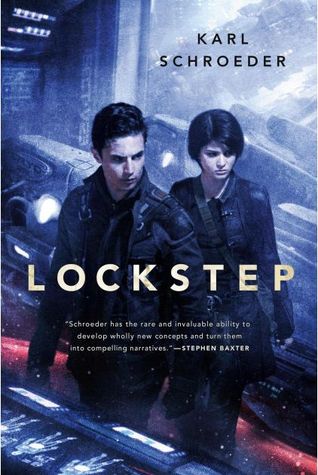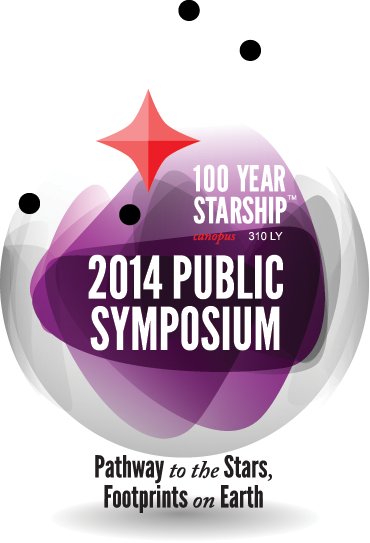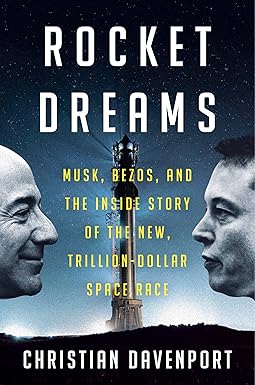Centauri Dreams
Imagining and Planning Interstellar Exploration
Thoughts on Karl Schroeder’s ‘Lockstep’
We last heard from Karl Schroeder in his essay Creative Constraints and Starflight, published here back in March. Schroeder was describing his new novel Lockstep, whose ingenious plot is in the service of a daring idea: If we are limited to speeds well less than that of light, can we still find a way to achieve the kind of deep space civilization we’ve seen depicted in so much science fiction? That would include travel to far places within single human lifetimes, trade with colony worlds, and much of the panoply of what is sometimes called ‘space opera.’
Schroeder’s solution is ingenious and challenges the preconceptions most of us bring to interstellar flight, which is why I want to return to Lockstep this morning. I had read a pre-publication copy late in 2013 and found that it triggered some incipient thoughts on how we relate to time that I needed to work out. In particular, not only in Karl’s work but in Neal Stephenson’s and, to an extent, in Alastair Reynolds’, I’ve found a creative re-casting of our relationship to time and how we measure it off in terms of a single human lifetime. Exactly what is ‘subjective’ time, and is there a specific way it should relate to ‘objective’ time?
The question Schroeder forces upon us is whether time is best measured as a clock-driven passage of minutes, hours and days (I call it ‘objective’ time while acknowledging its malleability in the form of spacetime), or as an accumulation of life experiences that can be separated from this objective time. In the world of our experience, we may think of time as a substrate through which we move — we have so many years in our lives and the clock is always ticking in the background. In the world of Lockstep, that ticking can be suspended. Adjusted. The human experience of time is what it has always been, but the world around it is accelerated.
Benefits of Adjusted Chronology
We’re in a world where suspended animation is routine and about as eventful as getting into bed for a good night’s sleep. You might sleep a day, or a year, or in the case of young Toby McGonigal, the book’s protagonist, a breathtaking 14,000 years before waking up. While conventional, day to day life goes on elsewhere, the Lockstep worlds are those that have entered into a contractual arrangement to use suspended animation to stay synchronized. A 360/1 schedule, the primary one in this culture, keeps people suspended for 359 months out of every 360. It’s this last month in which they awake and get about the business of civilization.
Karl has already described this scenario in our pages and we’ve had discussions about its pluses and minuses. But let’s look back and review for a moment what a society like this gets from this strange arrangement. You can see that the so-called ‘fast worlds’ — the inner planets, for example, living as we do today without recourse to suspension — suffer from constraints that the tiny outer worlds in the far Kuiper Belt and beyond don’t endure. As Toby gets used to the world he has awakened into, he marvels at its fecundity. “We’re in the middle of nowhere between the stars but this place seems as rich as Earth. Though that can’t be.”
But of course it is, for reasons he comes to learn, just as he learns the key role his own family has played in this outcome. Schroeder describes all this in terms of computer technology. The locksteps, small worlds synchronized on their schedules with each other, form a synchronous network, with each node acting at the same time. In other words, imagine a large number of tiny, isolated worlds in the Oort Cloud, all sending out their cargo (including passenger ships) on the same schedule. Tuning the ‘frequency’ properly can turn desolate outposts into economically viable societies, for reasons Schroeder is careful to explain in a book where the consequences of this tuning are extremely well thought out and depicted with real panache.
There were tiny colonies that didn’t own even a chunk of cometary ice but harvested the impossibly thin traces of gas found between the stars using modified magnetic ramscoops. In an abyss so empty that there was only one hydrogen atom per cubic centimeter, the scoops filled their vast lungs like baleen whales filtering tenuous oceanic plankton. It could take them decades to fuel a single fusion-powered ship with enough hydrogen to visit their nearest neighbor. Yet even these little starevelings could contribute to the wealth of Lockstep 360/1, because its clock ticks were slow enough for them to keep up.
Automate your industry and go to sleep. When sufficient time has passed to allow the accumulation of a viable amount of resources, you emerge to engage in the necessary trade with other worlds like your own, worlds on the same schedule. A richer world might join a faster lockstep since it could manufacture goods at a greater clip, but even the poorest world has the chance to be part of a functioning civilization at a slow speed. Travel between the worlds takes a lot of time — remember, we’re in a world where Einstein’s speed limit still applies — but on a 360/1 schedule, you might travel half a light year while ‘wintering over,’ as Schroeder calls it.
That makes long periods of suspended animation a genuine plus for those with a yen to engage with the greatest number of the more distant worlds. A wintering over journey at a 36/1 schedule can have a certain number of destinations within range, but a 360/1 lockstep can deal with a thousand times more worlds. Doubling the distance you can travel opens up more distant worlds scattered through three-dimensional space, and a kind of empire can emerge that has resonances with everything from Doc Smith’s clanky space tales to the world of Star Trek.
Differentiation of the Culture
But back to the human experience of time, which is what fascinates me about what Schroeder is doing here. The understandable immediate reaction to a lockstep is that it simply slows the pace of discovery — how to progress when people only wake up briefly every thirty years? But the question is, progress on whose terms? For those whose lives take place within the lockstep, the framework of time outside has been abandoned. They still can expect to live their allotted lifetime, but it’s a lifetime that might take in vast stretches of time during which, to civilizations not in a lockstep, their own empires might rise and fall as the lockstep goes about its way.
All he could really sort out was that humanity and its many subspecies, creations and offspring had experienced many rises and falls over the aeons. Since they had the technology, and lots of motivations, people kept reengineering their own bodies and minds. They gave rise to godlike AIs, and these grew bored and left the galaxy, or died, or turned into uncommunicative lumps, or ran berserk in any of a hundred different ways. On many worlds humans wiped themselves out, or were wiped out by their creations. It happened with tedious regularity. The only reason there were humans at all, these days, was that there were locksteps.
I think this is fascinating — the lockstep as a backup, a repository for the entire species. Schroeder continues:
They served as literal freezers, preserving ancient human DNA and cultures. All kinds of madness might descend upon the full-speed worlds circling the galaxy’s stars — expansions, contractions, raptures, uploading, downloading, mind control, and body-swapping plagues (quite apart from the usual wars, dark ages and terraforming failures) — but everybody ignored those useless frozen micro-worlds drifting between the stars. Their infinitesimal resources and ancient cultures held no interest to the would-be gods of the inner systems. So once those would-be gods had wiped themselves out, the telltale silence from formerly buzzing stars would alert this or that lockstep, and they would send some colonists back. A few millennia later, the human population on Earth and the other lit worlds would again number in the billions or trillions, and some of those would return to the locksteps…
It’s a way of living deep into the remote future, this lockstep, and it sets up levels of civilization that work at different rates of time, from those who continue, as we do, to live one day for every day that passes, to those who adjust that schedule according to the needs of their environment, which out in the Kuiper Belt or Oort Cloud can be quite different. Freeman Dyson has often talked about the biological differentiation that will occur in our species as we adjust to varying conditions moving outward from the Sun. Schroeder is describing a chronological evolution that takes place as entire cultures become disconnected by their choice of calendars.
So how do you feel about it? Is sleeping for thirty years a waste of time? Or is a lockstep a way to continue to live your entire life while what gets ‘burned’ is time that is of little value to you? I’ve always found Karl Schroeder’s work provocative, but Lockstep is a book that keeps coming back to me at odd moments, as I wonder whether people would voluntarily enter into these arrangements in a world where suspended animation was easy, and whether the benefits of a lockstep to the teeming worlds on the Solar System’s edge would outweigh the break from the culture that had spawned the original colonists. I don’t have the answers here, but good science fiction, and this is very good science fiction, asks extraordinarily provocative questions.

A Layered Ocean within Ganymede?
Remember as you ponder NASA’s Request for Information about a Europa mission that the agency is contributing three instruments to the European Space Agency’s JUpiter ICy moons Explorer (JUICE) mission, to be operational in Jupiter space in the 2030s. The goal here is to explore Europa, Callisto and Ganymede through numerous flybys, with the craft finally settling into orbit around Ganymede. This would be the first serious look at multiple Jupiter moons by a visiting spacecraft since the Galileo mission, which explored the system from 1995 to 2003.
The large Jovian moons have always been of interest, with not just Europa but Callisto and Ganymede also thought to have deep oceans beneath their icy crusts. Galileo, in fact, found evidence for salty seas within Ganymede, probably containing magnesium sulfate. At the Jet Propulsion Laboratory, a team led by Steve Vance is offering new research showing that what we may have on Ganymede is more than a simple sea between two layers of ice. Using computer modeling of the processes involved, the scientists are talking about regions of ice and oceans stacked in layers. “Ganymede’s ocean might be organized like a Dagwood sandwich,” says Vance.
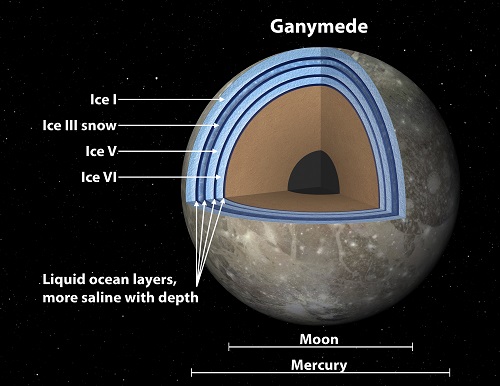
Image: This artist’s concept of Jupiter’s moon Ganymede, the largest moon in the solar system, illustrates the “club sandwich” model of its interior oceans. Scientists suspect Ganymede has a massive ocean under an icy crust. Previous models of the moon showed the moon’s ocean sandwiched between a top and bottom layer of ice. A new model, based on experiments in the laboratory that simulate salty seas, shows that the ocean and ice may be stacked up in multiple layers, more like a club sandwich. Credit: NASA/JPL.
Larger than Mercury, Ganymede may have 25 times the volume of water found on Earth. The JPL work, reported in a new paper in Planetary and Space Science, suggests that the sea bottom in the various layers may not be coated with ice but with salty water. Earlier models had shown the probability of dense ice at the bottom of a huge ocean with enormous pressures, but Vance’s team added salt to its models and found that liquid dense enough to sink to the sea floor was the result. Salt, as it turns out, makes the ocean denser, particularly under the extreme pressure conditions found within Ganymede and other moons.
Oceanic pressure on Ganymede would be high, for the moon’s oceans may be up to 800 kilometers deep. The deepest, densest form of ice thought to exist on Ganymede is known as Ice VI. If ordinary refrigerator ice (Ice I) floats in a glass of water, heavier forms of ice produced by extreme pressures show much more compact crystalline structure, with the molecules packed more tightly together, which is why some forms of ice can fall to the bottom of the ocean.
That would seem to produce an icy ocean floor, making potentially life-producing chemical interactions between water and rock unlikely. But the team’s models show up to three ice layers and a rocky seafloor, with the lightest ice on top and salty, dense liquid at the bottom. Moreover, the layers in the diagram above account for odd phenomena, with Ice III in the uppermost ocean layer being formed in the seawater and salts precipitating out. As the heavier salts begin to settle to the bottom, the lighter ice would float upward, perhaps melting again before it reaches the top of the ocean or leaving slush layers in the Ganymede ocean. When it’s snowing on (or within) Ganymede, in other words, the snow floats up, not down.
This JPL news release offers more, including the notion that the ‘club sandwich’ structure the researchers describe varies over time, sometimes returning to a single ocean found below a layer of Ice I and existing on top of regions of different high-pressure ices. In any case, the idea of chemical interactions where water and rock meet is intriguing from an astrobiological viewpoint, suggesting that a wet seafloor could produce the necessary conditions for life. The salts the Vance team added to its model can produce a sea bottom with the needed dense liquids.
The paper is Vance et al., “Ganymede?s internal structure including thermodynamics of magnesium sulfate oceans in contact with ice,” Planetary and Space Science published online 12 April 2014 (abstract). Also of interest: Vance et al., “A Passive Probe for Subsurface Oceans and Liquid Water in Jupiter’s Icy Moons,” submitted to Icarus (preprint).

The Europa Imperative
Stanley G. Weinbaum is best known for the 1934 short story “A Martian Odyssey,” lionized by readers and critics alike after it appeared in the July issue of Wonder Stories. Isaac Asimov would later opine that “A Martian Odyssey” was one of a handful of stories that changed the way all later science fiction was written. But Weinbaum’s depiction of a genuinely alien being called Tweel sometimes obscures his other work, which you can find collected in The Best of Stanley G. Weinbaum (1974), a worthwhile addition to the library of any SF fan, and a reminder of the loss the genre suffered when the author died at age 33.

This morning I’ve been thinking back to a little known Weinbaum story called “Redemption Cairn,” which ran in the March, 1936 Astounding Stories and which, because I have a good run of Astounding issues from that era, sits not ten feet away from me on my shelf. I don’t know if this is the first appearance of Europa in science fiction, but “Redemption Cairn,” with its exotic biosphere in a valley on the moon, shows us a time when Jupiter was thought to produce enough heat to make the Galilean moons habitable. Arthur C. Clarke would imagine a warm Europa as well, but his, in 2061 Odyssey Three (1988) was the result of Jupiter’s transformation into a small star and the birth of a biosphere.
One thing we’re not going to find when we get a dedicated probe to Europa is a tropical habitat, but the musings of science fiction writers remind us that we shape our aspirations around our dreams, and the encounter with the unknown becomes just as meaningful in real life whether the ocean we’re probing lies under balmy skies or a kilometers-thick layer of ice. Want to see an icy, science fictional Europa? Try Kim Stanley Robinson’s Galileo’s Dream, in which the astronomer is transported from Padua into the depths of Europa’s deep ocean.
Image: Science fiction pioneer Stanley G. Weinbaum.
A NASA Request for Information
Galileo had plenty of Europan connections, from being the person who discovered the moon to having his name attached to the spacecraft that sent us our best images of the surface. Like all of us, NASA would like more information about Europa than the Galileo mission could provide, and while it takes science fiction to get us into the Europan ocean for now, down the road we may have more concrete options. The agency’s recent issuance of a Request for Information (RFI) asks the scientific and engineering communities to come up with ideas that can help us answer some of our longest-standing questions. The ultimate goal: A $1 billion mission (excluding launch) that can achieve the following goals, or at least as many of them as possible:
- Characterize the extent of the ocean and its relation to the deeper interior
- Characterize the ice shell and any subsurface water, including their heterogeneity, and the nature of surface-ice-ocean exchange
- Determine global surface, compositions and chemistry, especially as related to habitability
- Understand the formation of surface features, including sites of recent or current activity, identify and characterize candidate sites for future detailed exploration
- Understand Europa’s space environment and interaction with the magnetosphere.
These requirements come from the National Research Council’s 2011 Planetary Science Decadal Survey. Why we need a mission like this is clear enough. For all its achievements, Voyager could give us nothing more than a quick flyby, and while the Galileo spacecraft was able to make repeated flybys (fewer than a dozen), it labored under serious communications problems with the failure of its high-gain antenna. We’ve seen what Cassini can do in the Saturn system with repeated observations of high-value targets like Titan and Enceladus, but Europa is a tough nut to crack, particularly given the radiation environment that surrounds Jupiter.
For more on the RFI, whose deadline is May 30, visit the NSPIRES site. NASA has been funding work into mission concepts and in particular the science instruments that will be needed for Europa, including possible ways to penetrate surface ice. The Decadal Survey considers a Europa mission among the highest priority scientific pursuits for the agency, and the recent findings from Hubble of possible water vapor ejections from the moon’s surface add punch to the statement. The RFI, says John Grunsfeld, associate administrator for the NASA Science Mission Directorate at the agency’s headquarters, “is an opportunity to hear from those creative teams that have ideas on how we can achieve the most science at minimum cost.”
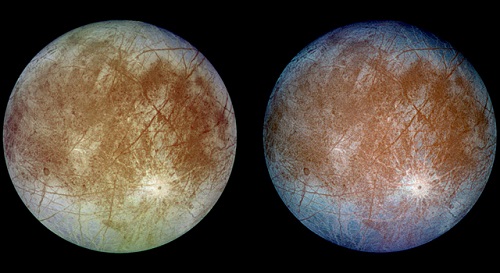
Image: Two views of the trailing hemisphere of Jupiter’s ice-covered satellite, Europa, returned by the Galileo spacecraft. The left image shows the approximate natural color appearance of Europa. The image on the right is a false-color composite version combining violet, green and infrared images to enhance color differences in the predominantly water-ice crust of Europa. Dark brown areas represent rocky material derived from the interior, implanted by impact, or from a combination of interior and exterior sources. Bright plains in the polar areas (top and bottom) are shown in tones of blue to distinguish possibly coarse-grained ice (dark blue) from fine-grained ice (light blue). Long, dark lines are fractures in the crust, some of which are more than 3,000 kilometers (1,850 miles) long. The bright feature containing a central dark spot in the lower third of the image is a young impact crater some 50 kilometers (31 miles) in diameter. This crater has been provisionally named “Pwyll” for the Celtic god of the underworld. Credit: NASA/JPL.
Through Galileo’s Lens
But back to science fiction, and Kim Stanley Robinson, a fine science fiction author indeed. In Galileo’s Dream, before the celestial voyaging that will give Galileo a much closer look at what he sees in his telescope, Robinson depicts the discovery of the Galilean moons:

On the night of January 12, Galileo trained the glass on Jupiter in the last moments of twilight. At first he could see again only two of the little bright stars, but an hour later, when it was fully dark, he checked again, and one more had become visible, very close to Jupiter’s eastern side.
He drew arrows trying to clarify to himself how they were moving, shifting his attention between the view through the glass and his sketches on the page. Suddenly it became clear, there in the reiterated sketches: the four stars were moving around Jupiter, orbiting it in the same way the moon orbited the Earth. He was seeing circular orbits edge-on; they lay nearly in a single plane, which was also very close to the plane of the ecliptic, in which the planets themselves moved.
He straightened up, blinking away the tears in his eyes that always came from looking too long, and that this time came also from the sudden urge of an emotion he couldn’t give a name to, a kind of joy that was also shot with fear. “Ah,” he said. A touch of the sacred, right on the back of his neck: God had tapped him. He was ringing.
Image: Portrait of Galileo by Ottavio Leoni (1578-1630).
The pace of space exploration is sometimes frustrating, particularly when we gauge it against the optimism of the Apollo era and the dreams of von Braun. But when I think about Europa and our opportunities there, I always think back to this passage in Robinson, and ultimately back to Galileo himself. We have come so far since the days when he identified those bright objects around Jupiter as moons. Surely the drive for discovery — the zest, the enchantment of it — that drove Galileo is something hard-wired into our species, a sort of ‘ringing,’ as Robinson describes it, or perhaps a kind of inner fire that won’t allow us to turn away from these explorations.

Night and Day on ? Pictoris b
Writing yesterday about Kevin Luhman’s discovery of another cold brown dwarf in the stellar neighborhood reminded me of work we discussed earlier this year in which the weather on the surface of Luhman 16 B was mapped. This was done using the European Southern Observatory’s Very Large Telescope (see Focus on the Nearest Brown Dwarfs), which found variations in the brightness of one of the two dwarfs in this interesting binary just six light years from the Sun. We are beginning, in other words, to chart features in the atmosphere of a brown dwarf whose atmosphere is 1100 degrees Celsius and filled with molten iron and minerals.
With that in mind, the news that Dutch astronomers also using the Very Large Telescope (with the CRIRES spectrograph) had measured the rotation rate of an exoplanet immediately caught my eye. Beta Pictoris b orbits its primary some 63 light years from Earth in the constellation Pictor (The Painter’s Easel). It was one of the first exoplanets to be directly imaged and, at a distance of 8 AU, the closest exoplanet to its star that has ever been imaged. Now we learn that the equatorial rotation velocity of the planet is almost 100,000 kilometers per hour.
Bear in mind that Beta Pictoris b is about 3000 times more massive than the Earth and some sixteen times larger, yet a day on this world lasts a paltry eight hours. We can contrast that with Jupiter’s equator, whose cloud cover rotates at 47,000 kilometers per hour, or with the Earth, whose rotation rate is a comparatively puny 1674.4 kilometers per hour. What we’re seeing here is an extension of the relationship between mass and rotation that we’ve already observed in the Solar System. Remco de Kok is a co-author on the paper announcing the find:
“It is not known why some planets spin fast and others more slowly,” says de Kok, “but this first measurement of an exoplanet’s rotation shows that the trend seen in the Solar System, where the more massive planets spin faster, also holds true for exoplanets. This must be some universal consequence of the way planets form.”
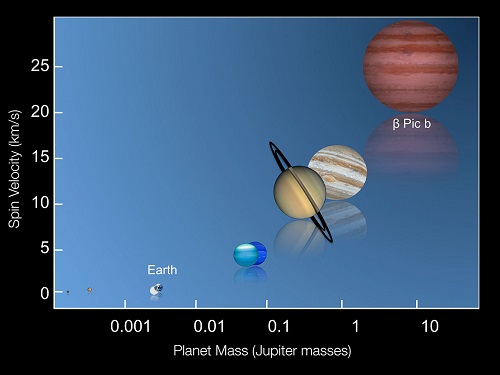
Image: This graphic shows the rotation speeds of several of the planets in the Solar System along with the recently measured spin rate of the planet Beta Pictoris b. Credit: ESO/I. Snellen (Leiden University).
That we could make such measurements of this young world (Beta Pictoris b is about 20 million years old) is an indication of advancing techniques similar to those that brought us the weather on Luhman 16B. The researchers, from Leiden University and the Netherlands Institute for Space Research (SRON), studied changes in the wavelength of received light to detect the different speeds and direction of different parts of the planet. This was exquisitely challenging work in that it involved separating this already tiny signal from the light of the parent star.
The team’s variation on Doppler imaging allowed measurements of the wavelengths of radiation from the planet to a precision of one part in 100,000, enough to detect the velocity of the various parts of the planet’s atmosphere that are emitting light. “Using this technique we find that different parts of the planet’s surface are moving towards or away from us at different speeds, which can only mean that the planet is rotating around its axis,” adds lead author Ignas Snellen.
We can imagine future work not only in creating a global map of Beta Pictoris b’s cloud patterns but, with the help of the upcoming European Extremely Large Telescope (E-ELT) and its planned METIS spectrograph and imager, maps of exoplanets much smaller in size. For now, though, Beta Pictoris b may remain the target of the team’s near-term studies. From the paper:
The SNR [signal-to-noise ratio] that can be achieved on a planet spectrum for this type of observation is a strong function of telescope diameter D. This opens the way of obtaining two-dimensional maps of the planet using Doppler imaging, a technique used to map spot distributions on fast-rotating active stars. Very recently, a first Doppler image map was produced for the nearby brown dwarf Luhman 16B (K=9.73) using CRIRES on the VLT, showing large-scale bright and dark features, indicative of patchy clouds. The planet ? Pictoris b is only a factor 13 fainter than Luhman 16B. Our simulations…show that a similar study can be conducted on ? Pictoris b using future instrumentation.
The paper is Snellen et al., “The fast spin-rotation of a young extra-solar planet,” to be published online in Nature 1 May 2014.

Luhman’s Latest: A New, Nearby Brown Dwarf
Kevin Luhman (Pennsylvania State University) has focused much of his research on the formation of low-mass stars and brown dwarfs in star-forming regions near the Sun. This involves working with relatively young stars, but Luhman is also on the alert for older objects, very cool brown dwarfs in the solar neighborhood. Brown dwarfs cool over time, and as Luhman describes on his university web page, they are ‘valuable laboratories for studying planetary atmospheres.’ They also give us a chance to test theories of planet formation in extreme environments.

Now we have Luhman’s latest, and it would not be a surprise if the whole category of nearby, cool stellar objects begins to get referred to as ‘Luhman objects’ or some such. Remember that it was just back in March that the astronomer discovered, using WISE images, a binary brown dwarf system at a scant 6.5 light years from Earth. The new find is WISE J085510.83-071442.5. It has the third highest proper motion and the fourth largest parallax of any known star or brown dwarf, and can lay claim to being, at least for a time, the coldest brown dwarf on record.
Image: Penn State’s Kevin Luhman, a specialist in low mass stars and brown dwarfs, who is filling in our map of such objects close to the Sun.
How cold? This object is thought to be between -48 to -13 degrees Celsius, colder than previous record holders, which were found to be close to room temperature. WISE imagery from 2010 was confirmed by two additional images taken by Spitzer in 2013 and 2014, with further observations at the Gemini South telescope on Cerro Pachon in Chile. The WISE and Spitzer data were used to measure the distance to the object via parallax. It turns out to be 7.2 light years away, fitting nicely into the chart below, which shows the Sun’s immediate neighborhood.
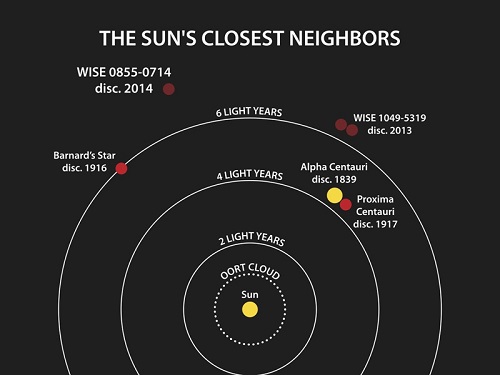
Image: This diagram illustrates the locations of the star systems closest to the sun. The year when the distance to each system was determined is listed after the system’s name. NASA’s Wide-field Infrared Survey Explorer, or WISE, found two of the four closest systems: the binary brown dwarf WISE 1049-5319 and the brown dwarf WISE J085510.83-071442.5. NASA’s Spitzer Space Telescope helped pin down the location of the latter object. The closest system to the sun is a trio of stars that consists of Alpha Centauri, a close companion to it and the more distant companion Proxima Centauri. Credit: NASA/Penn State University.
That’s a fascinating chart, and while all of us can share the determination to learn more about brown dwarf and planet formation and the atmospheres of cold objects, some of us also think in terms of targets for future probes, hoping that brown dwarf hunter Luhman may turn up something even closer than the three he has already discovered. Objects as cool as Luhman’s latest can all but disappear at visible wavelengths, but their infrared glow makes detection possible, with surely more to come. Thus Michael Werner, a Spitzer project scientist at JPL:
“It is remarkable that even after many decades of studying the sky, we still do not have a complete inventory of the sun’s nearest neighbors. This exciting new result demonstrates the power of exploring the universe using new tools, such as the infrared eyes of WISE and Spitzer.”
We’re talking about an object somewhere between 3 and 10 times the mass of Jupiter, which makes WISE J085510.83-071442.5 one of the least massive brown dwarfs known, if indeed it is a brown dwarf rather than a free-floating gas giant that has been expelled from some undetermined star system. Luhman comments on the latter possibility in the paper on this work:
At this mass, WISE 0855?0714 could be either a brown dwarf or a gas giant planet that was ejected from its system. The former seems more likely given that the frequency of planetary-mass brown dwarfs is non-negligible while the frequency of ejected planets is unknown. Assuming that WISE 0855?0714 is a Y dwarf, the four closest known systems now consist of two M dwarfs and one member of every other spectral type from G through Y.
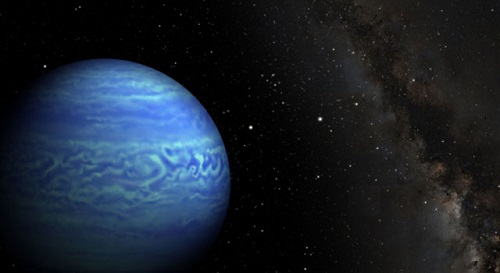
Image: This artist’s conception shows the object named WISE J085510.83-071442.5, the coldest known brown dwarf. Brown dwarfs are dim star-like bodies that lack the mass to burn nuclear fuel as stars do. WISE J085510.83-071442.5 is as cold as the North Pole (or between minus 48 to minus 13 degrees Celsius). The color of the brown dwarf in this image is arbitrary; it would have different colors when viewed in different wavelength ranges. Credit: NASA/JPL-Caltech/Penn State University.
The paper goes on to note that the newly discovered brown dwarf now offers the chance to test various atmospheric models in an unexplored temperature regime, something that will require refining the parallax measurement and ‘deeper near-IR photometry to better constrain its spectral energy distribution.’ We’ll also need to take advantage of near-term advances in our spectroscopy of the sort the James Webb Space Telescope should make available.
The paper is Luhman, “Discovery of a ~250 K Brown Dwarf at 2 pc from the Sun,” The Astrophysical Journal Letters Vol. 786, No. 2 (2014), L18 (abstract / preprint). A JPL news release is also available.

Interstellar Conferences for 2014
2014 isn’t nearly as top-heavy with interstellar conferences as the year before, but we do have two to discuss this morning, both of them slated for fall in North America. Looking through the preliminary information, I’m remembering how many good sessions grew out of last year’s meetings. For a field that grew up fueled largely by the enthusiasm of individuals who met in person only rarely, we suddenly found ourselves with the 100 Year Starship conference in Houston, Icarus Interstellar’s Starship Congress in Dallas, two Starship Century events (one in London, one in San Diego), the Tennessee Valley Interstellar Workshop (version 2) and a London conference on what Bob Parkinson so wonderfully calls ‘the philosophy of the starship.’
Various smaller get-togethers occurred as well, and so, of course, did huge space-dominated conferences like the International Astronautical Congress and other aeronautics, astronautics and SETI sessions around the world. But who would have thought even ten years ago, much less fifty, that we would be having multiple conferences in a single year arranged around starship topics, and that groups dedicated to studying the possibilities of interstellar flight would be proliferating? A friend and I were musing that we found ourselves living in a science fictional world, and the thought came that it just seemed that way because we were getting older. And, of course, we are, but it’s also true that deep space really has become a highly visible topic.
100 Year Starship Symposium 2014
The theme for this year’s 100 Year Starship Symposium is Pathway to the Stars, Footprints on Earth, a nod to the synergies the organization continues to seek out between the huge advances in technology and biological science we’ll need as we anticipate deep space missions and the developing spinoff tools we’ll gain from such work to improve life on Earth today. The symposium will be held at the George R. Brown Convention Center in Houston from 18 to 21 September.
Although registration for the actual event has not yet begun, the call for papers is now active, with abstract submissions manageable through the symposium site. The deadline for abstracts is May 31, with notification of acceptance on June 30. Accepted presentations and poster submissions are then due on the 10th of September. Quoting from the submission guidelines:
Submissions can be perspectives on the central dogma, experimental results, and review of a specific topic. You must ensure that it fits the track topic to which you are submitting. Individual presentations will only be presented in one track. Individuals do not have to be associated with an institution to submit an abstract. Please note that materials should be non-commercial in content, any commercial presentation that communicates a service, technology or product can be submitted to our poster session.
Submissions will be reviewed based on bona fide field of inquiry/thought/research that derive from validated patents, literature, mathematics or practice. The data submitted should represent one or more of the following:
Actual data or background search generated presents a challenge to current dogma or asks a significant question
Data moves the field forward or clarifies some aspect of the field
Solves a problem acknowledged in the field
Provides a novel, well supported integration and/or review of field and proposes specific concept
Submitted abstracts are well written, 300 word, concise and includes a statement of the following items. If actual data, results and conclusions are not available, please provide a well thought out plan for how the information will be generated.
Background
Problem and hypothesis
Experimental design (or literature review)
Data
Results
Conclusions and Discussion
The tracks are available on the symposium site. They range from propulsion and energy to near-term spinoff technologies, data, communications and information technology, and major issues of life support and sociology. The data and communication track is a new one, highlighting recent work on data retrieval and transmission at interstellar distances. Also new at the 2014 symposium will be a track on interstellar education, looking at the role of education at producing what the site calls ‘interstellar citizens’ and probing current and future educational practices. Poster presentations are available for discussions in a small group setting.
Tennessee Valley Interstellar Workshop
The third Tennessee Valley Interstellar Workshop will be held November 9-12 in Oak Ridge, Tennessee at the DoubleTree by Hilton Hotel with a theme of Long-Term Thinking–Present-Day Action. I’ve recently received the call for papers for this event, which was originally conceived by Les Johnson, Greg Matloff and Robert Kennedy in a wonderful hotel in the Italian alps in the town of Aosta. I remember the setting well, having spent several days there at one of the earlier Aosta conferences — it’s a place where long-term thinking seems to come naturally. Have a look at the TVIW website for further background, including Les’ summation of the event:
“The Tennessee Valley Interstellar Workshop is an opportunity for relaxed sharing of ideas in directions that will stimulate and encourage Interstellar exploration including propulsion, communications, and research. The ‘Workshop’ theme suggests that the direction should go beyond that of a ‘conference’. Attendees are encouraged to not only present intellectual concepts but to develop these concepts to suggest projects, collaboration, active research and mission planning. It should be a time for engaging discussions, thought-provoking ideas, and boundless optimism contemplating a future that may one day be within the reach of humanity.”
Presentation/paper and workshop topic submissions are now open through August 1, with the full papers and presentations due two weeks prior to the start of the meeting. Do note that this event is limited to 75 participants, with applications for attendance and further information about submissions made by email to tviw2014@tviw.us. A bit more from the call for papers:
Participants who do not wish to present a paper or facilitate a workshop will also be considered and are requested to submit a bio describing their involvement in the field of developing Interstellar concepts, including interstellar-related space science and technology and space advocacy. Submissions relating humanities, art and social sciences to interstellar exploration are also encouraged. Going to the stars will involve and engage most aspects of human society and innovation in all fields that may contribute are of interest. All Participants (including Presenters) are encouraged to bring a free-standing poster describing their Interstellar work, suitable for exhibition.
Presenters will be given thirty minutes to present their work including a Q&A session at the end, and it seems probable (though I haven’t confirmed this) that selected papers will be submitted to the Journal of the British Interplanetary Society for publication. Note, too, that on Sunday November 9, TVIW will conduct two seminars to which accepted attendees are invited, one a three-hour short course on space propulsion taught by Les Johnson, the other a course on terraforming, its methods and rationale, taught by Ken Roy. Registration for these seminars can be managed through the TVIW website once your attendance has been confirmed. Direct any questions about participation to registrar@tviw.us.
